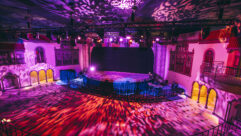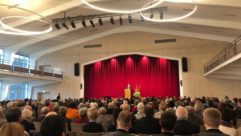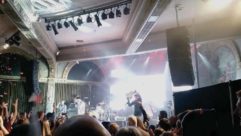sonic renewal
Jan 1, 2003 12:00 PM,
By Gregory DeTogne
Your money may not buy as much as it used to, but by any measure, $1.5 million is still a tidy sum of loot. In retrospect, it was an unspeakably huge amount back in 1923 when, with the Jazz Age cranking up to a feverish pitch, Aimee Semple McPherson spent just that to build the Angelus Temple. A grand domed structure near downtown Los Angeles that still stands today as a monument to the flamboyant evangelist and her charismatic ministry, the house of worship rises dramatically from the inner-city environs of Echo Park.
As a pioneer of incorporating theatricality and Hollywood-style production values into worship services as well as contemporary music, Sister Aimee would undoubtedly be pleased with the state of Angelus Temple’s continuing evolution. Recently renovated, the facility features A/V systems integration that brings extensive audio capabilities every bit as worthy of big-league touring acts to the room. Designed by Westlake Village, California-based McKay Conant Brook (MCB), the temple’s sonic blueprint was implemented by AMT Systems, a contracting firm from Santa Clarita, California.
Founded by McPherson the same year the Angelus Temple opened, the International Church of the Foursquare Gospel still maintains a strong following worldwide. As a way of expanding its outreach in Southern California, not long ago, the Foursquare group joined forces with the Dream Center, another L.A. ministry. Together the denominations have unified their efforts under the roof of the revitalized Angelus Temple, with the Dream Center’s executive associate pastor, David Hanley, presiding over the house of worship’s musical ministry. A true devotee of the rock ‘n’ praise concept, Hanley is one of the driving forces behind the Dream House, a full-tilt praise band that freely combines elements of rock, R&B, electronica, and even hip-hop into an amped-up style all its own.
“When I first met David Hanley,” says AMT Systems’ Tim Carlson, “I asked him what type of music currently heard within the Christian world would be comparable to his. He replied that there wasn’t any, and after listening to his band, I realized he was absolutely right. There are a lot of digital elements — some rap, rock, and R&B — but you can’t categorize it as belonging to any specific genre. One thing you can say, however, is that it is definitely high-energy. When his band takes the stage, those in the congregation need to hang on, because the music is going to be right in their faces, exceeding concert levels in a heartbeat. With this band appearing as a regular at Angelus Temple, I’d seriously be surprised if anyone ever needed an assistive listening device.”
Hanley’s musical vision was a major influence on the blueprint penned by MCB for Angelus Temple. In prioritizing his design concepts, he placed loud at the top of his list, followed by good stereo imaging, high fidelity, and intelligibility. “Unfortunately, the building in its natural state wasn’t even remotely suited to meeting these criteria,” says MCB principal Dave Conant. “While early documentation we discovered indicated that the room has perfect acoustics, such things were written well before the advent of sound reinforcement as we know it today. From what I understand, when Aimee preached, she was able to stand a good way back from the center of the room, where no one can stand today, and in doing so, the focus of the huge dome would have actually allowed her voice to cover a reasonable area of the seating sections.”
However, the dome presented a host of major problems for Hanley’s intended high sound-pressure level (SPL) uses. “For one thing, when we analyzed the environment, we uncovered a number of harsh reflections resulting from the interaction of sound traveling up into the dome, coming back down, and then striking the wall behind the stage, which is concave,” Conant says. “Long delayed echoes set up inside the dome returning to the stage and front portions of the seating area were also bothersome and greatly diminished intelligibility. Based upon further examination, we even found many seats in the balcony where focused, significantly delayed signals coming from the dome were more than 10 dB stronger than the direct sound arriving from the stage.”
To combat those ills, Conant mobilized his design staff. Instrumental in completing the plan were hardware and technical mavens Tim Waters and Randy Willis, both of MCB’s Media Systems Group, and Dan Bierenbaum and Tom McGraw of the firm’s Acoustics Group. While Willis, Waters, and their staff searched about for the right combination of electronics and sound-reinforcement components to help tame the hostile environment, Conant, Bierenbaum, and other members of the MCB acoustical team set about to see what they could do to alter the interior itself for the better, all while staying within parameters true to the structure’s place on the register of National Historic Landmarks.
WHEEL AND SPOKE
According to the renovation’s structural blueprint drawn by local architect E. C. Lind, the room’s 21st-century configuration would contain 3,065 seats spread across a main floor section and two steep balconies. Based upon its analysis, MCB concluded that the best way to approach the problematic acoustical aspects of the room was to utilize a concert-grade sound-reinforcement system that would specifically limit loudspeaker coverage to the seating areas. Taking advantage of line-source array technology provided MCB with a high direct-to-reverberant ratio of sound by minimizing the energy being spilled into reflective spaces within the room. In conjunction with this strategy, the firm also determined that there should be a limit on the number of audio sources in the environment and that acoustical treatments should be liberally applied wherever possible.
Shackled somewhat by the building’s landmark status, which effectively nixed the possibility of using any type of acoustical treatments that would permanently alter the room’s original design, MCB devised a “wheel-and-spoke” plan that deployed 57 baffles suspended just below the dome from cabling extending from a central point (the spokes) out to anchor points on the dome’s perimeter (the wheel).
“The baffles are large enough and close enough together that they absorb and scatter most of the sound waves trying to reach upward into the dome,” says McGraw. “Anything they don’t catch on the way up, they catch on the way back down. Comprised of either one or two panels, the baffles measure anywhere from 4-by-6 feet to 8-by-16 feet in size and are light enough not to pose a problem in this active seismic zone. On an aesthetic level, even with the baffles in place, people in the seats below can still look up without difficulty and experience the full depth perception of looking into the dome, which is subtly lit and painted with a cloud scene. This was one of the requirements of the preservationists.”
Thick applications of absorptive materials were also placed around the concave wall behind the stage to minimize the possibility of creating unwanted reflections. Once acoustical issues were resolved satisfactorily, AMT Systems was contracted by McCormick Construction on a design-build basis to implement the MCB design and performance specification, which was based upon the requirements of Hanley and the Dream Center. AMT worked with MCB and the Dream Center to provide the desired system performance within the tightly defined budget established by the Foursquare Church.
SONIC ANOMALIES
As a way of satisfying the goal of creating a high direct-to-reverberant ratio of sound, left/right line-source arrays were deployed using components supplied by L-Acoustics US in the form of 28 of the manufacturer’s dV-DOSC small-format array elements, 10 dV-SUB enclosures, and 8 SB218 subwoofer cabinets.
Employing an active, two-way design, each dV-DOSC module uses a pair of 8-inch drivers and a single 1.4-inch compression driver, fitted with a patented DOSC waveguide to produce interelement coupling for the upper-frequency ranges, providing a 120-degree horizontal pattern. Vertically, the boxes are adjustable in one-degree increments.
At the low end, each of the 10 dV-SUB cabinets are outfitted with three 15-inch transducers, whereas the eight SB218s pack a pair of 18s each. In its entirety, the array configuration was designed to provide in excess of 110 dB at the farthest row of seats while maintaining even SPL and frequency response throughout the church. As reflected in the L-Acoustics Array design program used for the project, each array provides tight 65-degree vertical coverage, with constant directivity control from below 400 Hz to 18 kHz. Carlson indicated that the Array software worked exactly as claimed. “The rig went up just as we predicted,” he says. “With the digital inclinometer showing exactly the angle predicted to provide the required vertical coverage, we used a laser placed on the array to verify the aim points and upper edges of the coverage pattern at ear height in the back row.”
According to the MCB plan, each left/right array incorporates 14 dV-DOSC enclosures as mid-high elements flown in a classic line array arc at the side of the stage, along with adjacent arrays of flown dV-SUBs numbering five apiece on each side. Doing their part to enhance LF punch, the SB218 subs were relegated to ground stacks of four on each side, making the frequency response of the system 28 Hz to 18 kHz (+3 dB).
“When you think of line array technology, traditionally, long, deep throws come to mind,” says Willis. “But in this facility, we were facing relatively short, wide throws. All that considered, we still needed a high degree of control to maintain the tight coverage patterns required. Our acoustics group did all it could to minimize the sonic anomalies inherent within the space, but we were still concerned about throwing unnecessary energy onto the walls and into the dome, because there was certainly a limitation to the number of corrective measures the project could afford both aesthetically and financially.” By necessity, the group had to find line array technology that would allow it to maintain the control coverage and provide the needed SPL but still get the width. “We investigated various 120-degree-wide line array packages by utilizing each manufacturer’s published data and proprietary line array modeling software to predict direct-field SPL with respect to the challenging seating layout,” Willis says. Dan Abrams, also of MCB’s Media Systems Group, contacted each manufacturer regarding building and optimizing the array models. “Information gleaned from that process helped us narrow the possibilities down to a shortlist of two that were appropriate for this project,” Willis says. “We then invited these two manufacturers, one with a large-format array and the other with a small-format solution, to conduct on-site demos for the client. Based upon their tight response and high-energy low-frequency impact, the small-format L-Acoustics product was ultimately chosen.”
HIGHER POWER
Power for the Angelus Temple’s main sanctuary rig comes from an assortment of custom amplifiers supplied by QSC Audio. Built with 32 dB gain to accommodate the L-Acoustics digital signal-processing preset’s protection limiting thresholds, ten PowerLight PL2.4MBs, six PL4.0s, two PL6.0PFCs, and four PL1.8 amplifiers took up residence in the house equipment racks, which are capable of producing a total of 91,800W as used in this application.
With the matters of acoustical treatments, maintaining a high direct-to-reverberant ratio, and power settled by the MCB design, the last bit of major criteria standing in the way of the project’s successful completion revolved around finding a way to limit the number of loudspeaker sources in the room. “The solution to that dilemma was really quite obvious,” MCB’s Waters says. “Given the fact that we were regularly going to be dealing with the 20 performers onstage who constitute the house band, the easiest and most efficient thing to do was reduce the stage volume through the use of in-ear monitors. I mean, with or without the acoustical challenges of this room, could you imagine having 20 people onstage with wedges under any circumstances?”
As it turned out, Hanley and the Dream House worship team were already well adapted to in-ear technology, having had wide-ranging experience with it while touring. Longtime users of Shure PSM 600 devices, they brought four wireless and four hardwired mixes to the stage, using a total of 13 wireless and 7 hardwired receivers and Shure’s E5 dual-driver earpieces. Along with available in-ear monitoring, two small wedges were also built in to the stage structure to provide fold-back reinforcement for the pastor and featured soloists. The units initially selected for this duty failed to perform adequately, so L-Acoustics MTD108a eight-inch coaxial units were used in order to deliver the high power levels required.
SINS AVERTED
Input at Angelus Temple is supplied by ten U24D/Beta 58 UHF wireless systems, also introduced into the blueprint from the Shure catalog. The bulk of the array crossover, EQ, and protective processing is handled by a BSS Audio 9088ii LL SoundWeb network using L-Acoustics factory presets, with an Ashly Audio GQX-3102, dual-channel ⅓-octave unit kept at the front-of-house mix position for making added manual tweaks as needed. House mixing takes place on a 40-channel Allen and Heath 5000 console. An assortment of additional outboard processing at hand includes an SPX-990 digital effects processor from Yamaha used mainly for reverb and an M3000 multi-effects processor provided by TC Electronic. Listen Technologies supplied the room’s assistive listening system, which, true to Carlson’s predictions, no one has needed yet.
Making its debut before an eager congregation on July 14, the renovated Angelus Temple greeted worshipers with spectacular pageantry and sonic showmanship far exceeding anything even in McPherson’s wildest dreams. “We are more than pleased with the capabilities of the audio system,” Hanley says. “It’s perfect for the room, and I really couldn’t ask for more. I’m especially impressed with the coverage — it’s the same at the very back of the church as it is right next to the loudspeaker columns. Vocals are crystal clear, and it doesn’t have that ‘honk’ characteristic of conventional horn-loaded systems. The quality of the design sold itself, and I was equally impressed with the installation crew. The job had to be done in an incredibly short amount of time, so everything was dialed in quickly, all while meeting everyone’s high expectations. Bottom line, the sound is transparent and goes a long way in covering a multitude of sins we’d have experienced in this room otherwise.”
Gregory DeTogne is a writer, a communications consultant, and the owner of an editorial public-relations firm in Libertyville, Illinois, specializing in pro-audio accounts.
For More Information
Allen and Heath
www.allen-heath.com
Ž 201
Ashly Audio
www.ashly.com
Ž 202
BSS Audio
www.bss.co.uk
Ž 203
L-Acoustics
www.l-acoustics.com
Ž 204
Listen Technologies
www.listentech.com
Ž 205
QSC Audio
www.qscaudio.com
Ž 206
Shure
www.shure.com
Ž 207
TC Electronic
www.tcelectronic.com
Ž 208
Yamaha
www.yamaha.com
Ž 209
Ž Circle this number on Reader Service Card or visit freeproductinfo.net/svc









